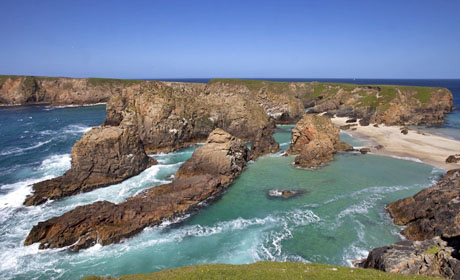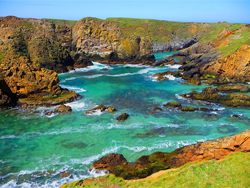Uyea
Unst, Shetland Isles, Scotland
 Spectacular Scenery
Spectacular Scenery
An uninhabited tidal island in Shetland, Uyea can be reached on foot from the Northmavine peninsular at low tide. Its rocky coast features several natural arches.
Shetland Geology

The oldest rocks in Shetland are a basement platform on which all Shetland's younger rocks lie. We can only see the basement where the younger rocks have eroded away or where it has been pushed towards the surface during mountain building episodes.
Shetland's oldest rocks formed about 2900 million years ago during the Archaean Era when Earth was a very different place. The sky was red, the atmosphere would have been fatal to us since it had no oxygen, and the tides and currents would have been more extreme because the moon was thousands of kilometres closer to Earth.
The rocks were originally granite which formed from silica rich magma that cooled within the Earth's crust. Later, magma rich in iron and magnesium was injected into the granite and cooled to form gabbro. As the continents shifted these rocks were deeply buried and baked, resulting in the 'Lewisian gneisses' that are seen along the North Roe coast.
Younger rocks of the 'Moine Supergroup' were thrust over these gneisses between 480 and 390 million years ago during a mountain building event called the Caledonian Orogeny. Some of the Lewisian rocks that were deformed by this event while others remained unaltered.
Text: Geopark Shetland